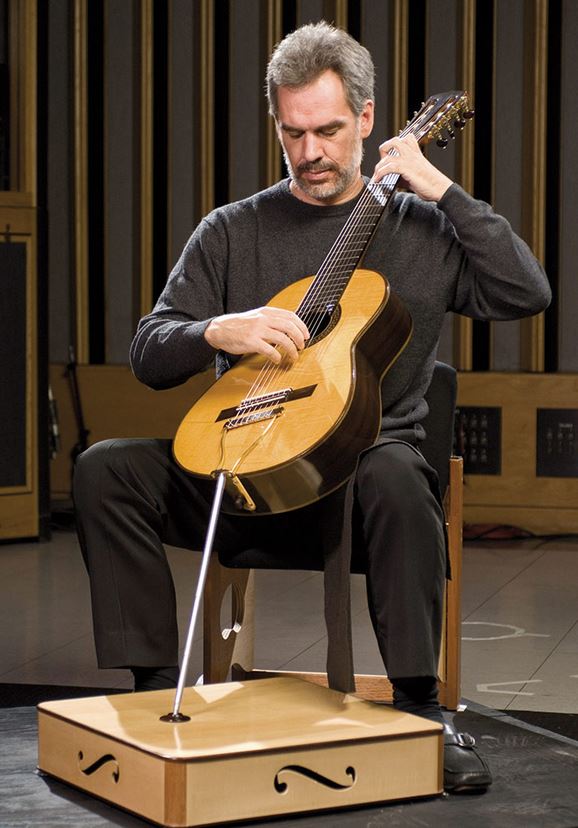Paul Galbraith, an unconventional technique for an unconventional guitar
Paul Galbraith is an outstanding artist, especially in his interpretation of J.S. Bach.
Galbraith, with the help of the great luthier David Rubio, has developed an entirely new type of guitar, the “Brahms guitar”, with eight strings (it adds a low A and high A) and a cello-like end-pin.
Using this guitar, Galbraith develops a new technique that allows to play a range of hitherto quite unplayable pieces by Bach, Brahms, and Haydn.
“As a guitarist I feel I am now able to start out again with a whole new world of unfolding possibilities, made available to me thanks to David Rubio and the development of the Brahms guitar.”
The technique
 Since 1984, Paul Galbraith start using a more natural and comfortable way of playing the guitar.
Since 1984, Paul Galbraith start using a more natural and comfortable way of playing the guitar.
Instead of using the traditional posture, with the guitar supported by a combination of the playing arm and one of the legs, he sat on the floor cross-legged, with the guitar supported between both legs, thus freeing his right arm.
“Holding and playing the guitar at the same time – with the same arm – inhibits this essential relationship between movement and sound, besides easily causing a twisting of the back and other physical problems”
Some years later, Galbraith further developed this new posture:
“Whilst playing guitar at Sérgio Abreu’s house in Brazil, he commented on the fact that by sitting with the guitar cross-legged in that way, I was dampening the most resonant part of the instrument. Then I came to the idea that I could take advantage of my already cello-like vertical posture, and use a cello end-pin, whilst sitting up on a chair again, thus liberating the full resonance of the instrument”.
His quest to overcome the guitar’s technical limitations led Paul Galbraith to develop a new instrument, which would better answer to his musical needs.
The “Brahms guitar”
Commonly referred to as the "cello-guitar", the Brahms guitar was originally conceived in order to perform Galbraith's arrangement of the Brahms Variations on an Original Theme Op. 21A for piano.

From Galbraith's website:
The name Brahms Guitar derives from my arrangement of the Brahms Variations on an Original Theme Op. 21A for piano, which I had initially transcribed for the 6-string guitar.
The instrument is an eight-string guitar, adding both a high and a low string to the conventional six string guitar.
Also from Galbraith's website:
I recognized that the question of increasing the bass range of the guitar was hardly a new one.
[...]
During a discussion, a close friend - the Italian guitarist Stéfano Grondona - suggested to me that in order to increase the available range within one position (and therefore also reduce stretching), an eighth string could be placed above the high E string, tuned a fourth above, to a high A.
So, the tuning adds a low A (a fifth below the standard low E, and a high A (a fourth above the standard high E), giving AEADGBEA.
The guitar's frets are fanned to allow for the different string lengths.
The instrument also has an external, box-shaped resonator, increasing its volume, and is held as one holds a cello, allowing ease and freedom to the body and hands.
The music
And finally, some videos of Paul Galbraith performances.
Adagio from Mozart's Sonata in B Flat Major, K. 570
https://www.youtube.com/watch?v=hqS66sXf1Bo
Frederico Mompou: Cancion nº 3 from Cançons i danses - El Noy de la Mare
https://www.youtube.com/watch?v=XrkkVNnW2jY